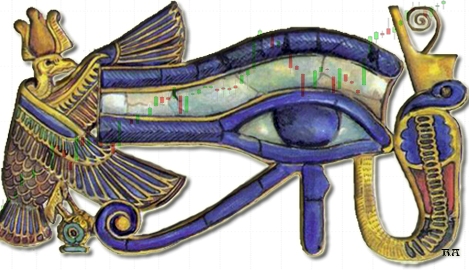
Price points for a Pollyanna bounceback
Week beginning October 15, 2012
Goldman Sachs has issued a "buy, buy, buy" alert and Citigroup's chief stock strategist is tipping "a raging Bull" market into 2013 with an SP500 target of 1615.
Copyright: Randall Ashbourne - 2011-2012
In predicting a strong rally, Goldmans is relying on the statistical norm of what tends to happen in US Presidential election years ... 87% of the time Wall Street spurts during the 4th Quarter, with an average gain of 3.5%.
Last weekend, we went through both weekly and long-range charts for a number of world indices in an effort to set probable upside and downside targets for the current month. We looked at a couple of planetary charts for the SP500 which indicated prices were likely to decline - and a couple for the Shanghai index, indicating it was likely to recover.
Monday brings a New Moon ... which tends to be a statistical high ... as well as a Mars trine from Sagittarius to Uranus in Aries; and on Tuesday Venus will square Jupiter. We'll have a look in a little while at exactly what Miss Pollyanna needs to do to get a boost from either of those astrological aspects
Last weekend, we went through both weekly and long-range charts for a number of world indices in an effort to set probable upside and downside targets for the current month. We looked at a couple of planetary charts for the SP500 which indicated prices were likely to decline - and a couple for the Shanghai index, indicating it was likely to recover.
Monday brings a New Moon ... which tends to be a statistical high ... as well as a Mars trine from Sagittarius to Uranus in Aries; and on Tuesday Venus will square Jupiter. We'll have a look in a little while at exactly what Miss Pollyanna needs to do to get a boost from either of those astrological aspects
And Gloom Boom & Doom guy, Marc Faber, spent last week reiterating his prediction of a 20% plunge in the same index.
For the moment, either scenario is possible - but there doesn't yet seem to be sufficient evidence to determine which one is probable.
For the moment, either scenario is possible - but there doesn't yet seem to be sufficient evidence to determine which one is probable.



Safe trading - RA
(Disclaimer: This article is not advice or a recommendation to trade stocks; it is merely educational material.)
I showed two charts last weekend which indicated the likely immediate path for Pollyanna was downwards ... because the index had topped out the previous week backing away from an exact price crossing point involving Mercury and Saturn.
I said at the time: "What normally happens with these points is that if price breaks through and Closes above the exact level, it sets the stage for a rally boost.
On the other hand, if price rises into the exact level and then backs away, the odds increase that an important target peak has been hit - and the immediate path ahead is downwards.
Friday's price action suggests this is what has happened ... and the negativity is strengthened because the block shows up in both directions."
Well, "what normally happens" did happen, in spite of the generally positive mood which prevails from 3Q to New Moon.
Statistically, markets tend to peak around the New Moon. But, there is the potential for either Mars trine Uranus, or Venus square Jupiter, to provide a boost.
I said at the time: "What normally happens with these points is that if price breaks through and Closes above the exact level, it sets the stage for a rally boost.
On the other hand, if price rises into the exact level and then backs away, the odds increase that an important target peak has been hit - and the immediate path ahead is downwards.
Friday's price action suggests this is what has happened ... and the negativity is strengthened because the block shows up in both directions."
Well, "what normally happens" did happen, in spite of the generally positive mood which prevails from 3Q to New Moon.
Statistically, markets tend to peak around the New Moon. But, there is the potential for either Mars trine Uranus, or Venus square Jupiter, to provide a boost.
In terms of the big picture, the index is still riding the central tyne of a Bullish pitchfork anchored at key long-range highs and lows. The rally angles within the pitchfork are extremely sharp - a result of all the money borrowed by central governments to boost the banks.
But before we do that, lets have another look at the Shanghai composite index. I indicated last weekend the main Chinese index may be bottoming at a primary Saturn line which played an important role as both Resistance and Support in the past. Those charts can be reviewed in the Archives (available from the buttons above).
We still have no croaking of the long-range Canary which would lend support to Marc Faber's view of an imminent plunge - though Faber has set a timeline of up to 6 months and we could get an instance of negative divergence by then.
Sticking with the big picture, let's review the weekly charts for the 500.
Sticking with the big picture, let's review the weekly charts for the 500.
As we anticipated, Shanghai is attempting to recover above the primary Saturn boundary, shown on the chart above with the thick cyan line ... and there is technical support for continued higher prices from the relatively mild positive divergence in the oscillator.
However, our main focus this weekend will be the state of Pollyanna, the SP500. Once again, my apologies to Canadian readers. Yahoo Finance stopped providing historical data for a number of indices back in June, including the TSX and DJI, and I'm having trouble finding a replacement data source.
However, our main focus this weekend will be the state of Pollyanna, the SP500. Once again, my apologies to Canadian readers. Yahoo Finance stopped providing historical data for a number of indices back in June, including the TSX and DJI, and I'm having trouble finding a replacement data source.
The last two peaks on the long-range Canary have come in lower than its peaks during the first stages of the recovery rally. That's a warning sign ... but, it's an early warning sign. There's another one from Pollyanna's apparent inability to rise above the highest level of the channel lines.
I published the long-range planetary chart and its prices last weekend, so you can check that if you need to. The chart above concentrates purely on three levels of technical horizontal support/resistance. We'll zoom-in now and have a closer look at that chart.
I published the long-range planetary chart and its prices last weekend, so you can check that if you need to. The chart above concentrates purely on three levels of technical horizontal support/resistance. We'll zoom-in now and have a closer look at that chart.
So, if Miss Polly fails the astro energy boost price crossings on Monday/Tuesday, the weekly chart above shows key levels of horizontal and diagonal Support likely to stall the fall.
And, really, there's not much else to look at. The charts in last weekend's edition remain valid for setting the likely range for the month in individual indices - and most of those indices will be influenced over the course of the next week by how the SP500 reacts. If that index can climb above the price crossing points, the Sagittarian effect is likely to exagerrate the optimistic outlook. If it fails the two tests, we're more likely to see fear rising and markets continue to fall.
And, really, there's not much else to look at. The charts in last weekend's edition remain valid for setting the likely range for the month in individual indices - and most of those indices will be influenced over the course of the next week by how the SP500 reacts. If that index can climb above the price crossing points, the Sagittarian effect is likely to exagerrate the optimistic outlook. If it fails the two tests, we're more likely to see fear rising and markets continue to fall.
And the key to direction will be how price performs on both Monday and Tuesday. On the chart to the right, note the intersection of the falling red Mars line with the thick yellow Uranus line.
It's at 1434. Pollyanna must close decisively above this level on Monday to re-enter rally mode. She gets a second chance at an astro energy boost on Tuesday, if she fails the 1434 Monday test.
In the chart above, the Venus square Jupiter price crossing point (rising green intersection with horizontal blue) is 1426.
So there are two things to watch for ... a Monday close above 1434, or a Tuesday low at 1426, from which price bounces.
Mars is now in Sagittarius and it'll be joined by the Moon later in the week. Sagittarius has a tendency to exaggerate either the optimism ... or the fear. And wide-range days are the norm when the Moon is in Sadge.
The first hint to which outcome is more likely will be provided by price performance on Monday and Tuesday and how the index reacts at the 1434, or 1426, price crossing points.
It's at 1434. Pollyanna must close decisively above this level on Monday to re-enter rally mode. She gets a second chance at an astro energy boost on Tuesday, if she fails the 1434 Monday test.
In the chart above, the Venus square Jupiter price crossing point (rising green intersection with horizontal blue) is 1426.
So there are two things to watch for ... a Monday close above 1434, or a Tuesday low at 1426, from which price bounces.
Mars is now in Sagittarius and it'll be joined by the Moon later in the week. Sagittarius has a tendency to exaggerate either the optimism ... or the fear. And wide-range days are the norm when the Moon is in Sadge.
The first hint to which outcome is more likely will be provided by price performance on Monday and Tuesday and how the index reacts at the 1434, or 1426, price crossing points.






